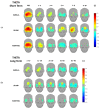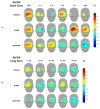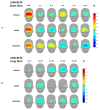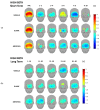Time-Dependent Analysis of Human Neurophysiological Activities during an Ecological Olfactory Experience
- PMID: 37759843
- PMCID: PMC10526851
- DOI: 10.3390/brainsci13091242
Time-Dependent Analysis of Human Neurophysiological Activities during an Ecological Olfactory Experience
Abstract
It has been demonstrated that odors could affect humans at the psychophysiological level. Significant research has been done on odor perception and physiological mechanisms; however, this research was mainly performed in highly controlled conditions in order to highlight the perceptive phenomena and the correlated physiological responses in the time frame of milliseconds. The present study explored how human physiological activity evolves in response to different odor conditions during an ecological olfactory experience on a broader time scale (from 1 to 90 s). Two odors, vanilla and menthol, together with a control condition (blank) were employed as stimuli. Electroencephalographic (EEG) activity in four frequency bands of interest, theta, alpha, low beta, and high beta, and the electrodermal activity (EDA) of the skin conductance level and response (SCL and SCR) were investigated at five time points taken during: (i) the first ten seconds of exposure (short-term analysis) and (ii) throughout the entire exposure to each odor (90 s, long-term analysis). The results revealed significant interactions between the odor conditions and the time periods in the short-term analysis for the overall frontal activity in the theta (p = 0.03), alpha (p = 0.005), and low beta (p = 0.0067) bands, the frontal midline activity in the alpha (p = 0.015) and low beta (p = 0.02) bands, and the SCR component (p = 0.024). For the long-term effects, instead, only one EEG parameter, frontal alpha asymmetry, was significantly sensitive to the considered dimensions (p = 0.037). In conclusion, the present research determined the physiological response to different odor conditions, also demonstrating the sensitivity of the employed parameters in characterizing the dynamic of such response during the time. As an exploratory study, this work points out the relevance of considering the effects of continuous exposure instead of short stimulation when evaluating the human olfactory experience, providing insights for future studies in the field.
Keywords: EDA; EEG; olfactory stimulation; physiological signals; signal processing.
Conflict of interest statement
The authors declare no conflict of interest.
Figures













Similar articles
-
The Impact of Odor Category Similarity on Multimedia Experience.Exp Neurobiol. 2024 Oct 31;33(5):238-250. doi: 10.5607/en24020. Exp Neurobiol. 2024. PMID: 39568180 Free PMC article.
-
Coherence analysis of EEG changes during olfactory stimulation.Clin Electroencephalogr. 1998 Apr;29(2):96-100. doi: 10.1177/155005949802900208. Clin Electroencephalogr. 1998. PMID: 9571297
-
A Behavioral and Electrophysiological Investigation of Effects of Visual Congruence on Olfactory Sensitivity During Habituation to Prolonged Odors.Chem Senses. 2020 Dec 5;45(9):845-854. doi: 10.1093/chemse/bjaa065. Chem Senses. 2020. PMID: 33035323 Free PMC article.
-
Intramodal Olfactory Priming of Positive and Negative Odors in Humans Using Respiration-Triggered Olfactory Stimulation (RETROS).Chem Senses. 2016 Sep;41(7):567-78. doi: 10.1093/chemse/bjw060. Epub 2016 May 11. Chem Senses. 2016. PMID: 27170666
-
The perception of odor is not a surrogate marker for chemical exposure: a review of factors influencing human odor perception.Clin Toxicol (Phila). 2013 Feb;51(2):70-6. doi: 10.3109/15563650.2013.767908. Clin Toxicol (Phila). 2013. PMID: 23387344 Review.
Cited by
-
Investigation of Deficits in Auditory Emotional Content Recognition by Adult Cochlear Implant Users through the Study of Electroencephalographic Gamma and Alpha Asymmetry and Alexithymia Assessment.Brain Sci. 2024 Sep 17;14(9):927. doi: 10.3390/brainsci14090927. Brain Sci. 2024. PMID: 39335422 Free PMC article.
-
Bridging the Gap between Psychophysiological and Audiological Factors in the Assessment of Tinnitus: An EEG Investigation in the Beta Band.Brain Sci. 2024 Jun 3;14(6):570. doi: 10.3390/brainsci14060570. Brain Sci. 2024. PMID: 38928570 Free PMC article.
-
Characterization of Cochlear Implant Artifact and Removal Based on Multi-Channel Wiener Filter in Unilateral Child Patients.Bioengineering (Basel). 2024 Jul 24;11(8):753. doi: 10.3390/bioengineering11080753. Bioengineering (Basel). 2024. PMID: 39199711 Free PMC article.
References
-
- Mancini M., Cherubino P., Cartocci G., Martinez A., Borghini G., Guastamacchia E., Di Flumeri G., Rossi D., Modica E., Menicocci S., et al. Forefront Users’ Experience Evaluation by Employing Together Virtual Reality and Electroencephalography: A Case Study on Cognitive Effects of Scents. Brain Sci. 2021;11:256. doi: 10.3390/brainsci11020256. - DOI - PMC - PubMed
-
- David O.A., David D.O., Mogoase C., Popescu L.C., Giosan C., Pellegrino A. Psychological effects and brain correlates of a rose-based scented cosmetic cream. J. Sens. Stud. 2019;34:e12536. doi: 10.1111/joss.12536. - DOI
Grants and funding
LinkOut - more resources
Full Text Sources
Research Materials
Miscellaneous

